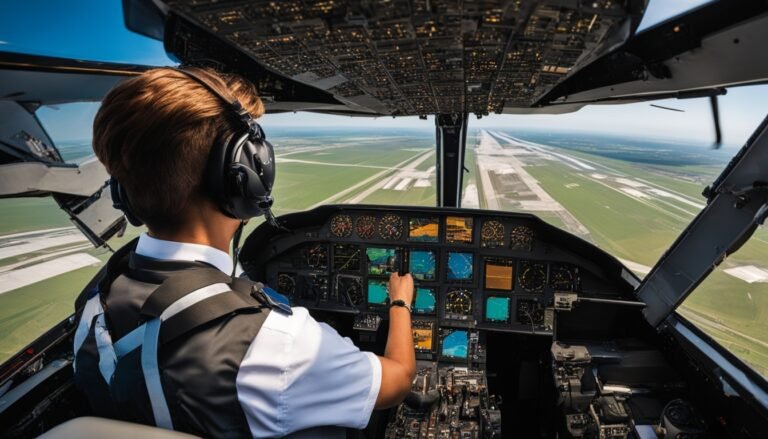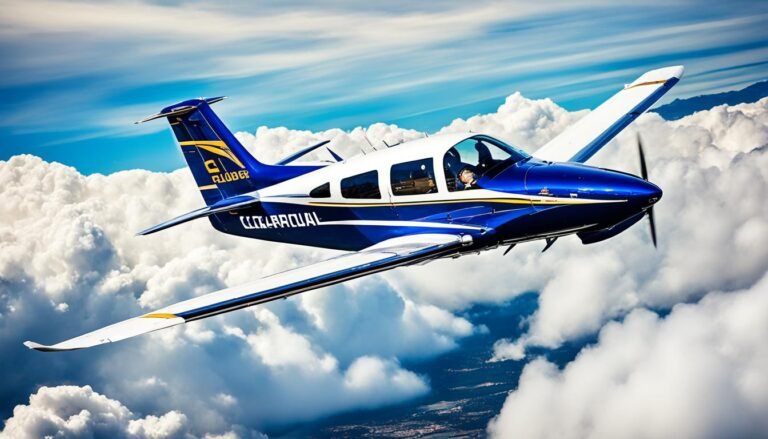Passenger Airplane Speed km/h Revealed

Have you ever thought about how fast passenger airplanes can fly? Do you wonder about the top speed they can reach? Or maybe you’ve always been curious about their average speed.
Let’s dive into the thrilling facts about how fast passenger airplanes move in kilometers per hour. Hold on tight and enjoy the ride as we explore the skies!
Key Takeaways:
- Passenger airplanes have varying speeds, with both average and maximum speeds determined by various factors.
- The average speed of commercial airplanes typically ranges from 800 to 900 kilometers per hour.
- Maximum speeds of passenger airplanes can reach over 950 kilometers per hour.
- Factors such as engine power, weight, and aerodynamics influence the cruising speed of an aircraft.
- Aerodynamics plays a crucial role in enabling an aircraft to achieve higher speeds.
Understanding Airplane Speed: Metrics and Terminology
Measuring airplane speed involves many key factors. This part will show you some important things. It helps understand how fast planes can go.
Key Metrics for Measuring Airplane Speed
The cruising speed is often used for passenger jets. This is how fast a plane flies when it’s level. It’s talked about in kilometers per hour (km/h). Wind, height, and the plane type affect this speed.
Airlines talk about their planes’ top speeds too. This shows how fast a plane can really go. Top speeds are also in kilometers per hour. But, planes usually don’t fly this fast during regular trips.
Airspeed is the speed of a plane against the air around it. It counts weight and air thickness. Pilots look at airspeed for safety. They watch it closely during takeoff, landing, and turns.
Plane speed is also about its movement in a certain direction. It mixes airspeed and wind speed together.
The Mach number is important too. It shows how fast a plane goes compared to sound speed. Mach 1 is as fast as sound. Mach 2 is twice that speed. This is key in planes that go faster than sound.
Learning about these things helps understand plane speed better. It shows the many parts making plane speeds possible.
The Significance of Cruising Speed in Passenger Planes
Passenger planes’ cruising speed is very important for their work and saving energy. It helps us see what planes can do and how they fly. Let’s learn about what makes cruising speed, how fast planes can go, and which planes are popular.
What Factors Determine Cruising Speed?
Many things affect how fast a plane can fly. The engine has the biggest effect. Planes with powerful engines can fly faster. The plane’s weight matters too. Lighter planes can fly at higher speeds. How the plane is shaped is also key. Good airplane shapes help it go fast and not use too much gas.
Fuel Efficiency and Operational Costs
Airplanes must be fast but also save fuel. Flying at the right speeds uses less gas. This lowers the money airlines spend and is good for the Earth. Airlines pick speeds that use gas the best for their trips. Doing this helps them make more money.
Comparing the Cruising Speeds of Popular Airliners
Different planes fly at different speeds. Here’s a look at how fast some well-known planes go:
| Airliner | Cruising Speed (km/h) |
|---|---|
| Boeing 747 | 913 |
| Airbus A380 | 907 |
| Boeing 787 Dreamliner | 907 |
| Airbus A350 | 903 |
These are just a few examples of how fast popular planes can go. Speeds change with height, weather, and flight plans.
A Closer Look at Commercial Passenger Airplanes and Their Speeds
We will get to know about commercial airplanes and their speeds. Let’s look at well-known airplane makers like Boeing and Airbus. And find out how fast these planes can go and land.
Commercial planes need speed for flying. The air speed is how fast it moves through the air. The ground speed is its speed over the Earth. Both are important for safe and smooth flights.
The Boeing 747 is a fast plane. It can fly up to 570 mph (920 km/h). Known as the “Queen of the Skies,” it has carried millions of people on long trips.
The Boeing 787 Dreamliner is also fast. It flies at about 560 mph (900 km/h). It’s good for the planet too, using less fuel than older planes. Airlines like it for saving money and the Earth.
Planes land at speeds between 130 and 150 mph (210 to 240 km/h). The speed depends on the plane’s size and weather. These speeds are set to make landings safe and smooth for everyone.
Lets see how fast some planes go. Here is a table showing max and landing speeds of famous planes:
| Aircraft Model | Maximum Speed (mph) | Landing Speed (mph) |
|---|---|---|
| Boeing 747 | 570 | 140-165 |
| Boeing 787 Dreamliner | 560 | 130-155 |
| Airbus A380 | 634 | 140-165 |
| Airbus A350 | 569 | 135-160 |
This table shows us how fast some planes can go. Remember, speeds can change with the plane and the weather. Air traffic control also plays a part.
In the future, planes will get faster and better. This will make flying more fun and help the planet. We look forward to these cool new planes.
Coming up, we will look at how airplane speeds have changed over the years. We’ll talk about important moments in plane history.
The Evolution of Passenger Airplane Speed Over Time
We will look at how passenger airplane speed has changed over time. We start from the first planes to today’s advanced aircrafts. This journey has opened up the world for us to explore and travel far and fast.
Historical Milestones in Passenger Jet Speeds
Commercial flights began a new era of travel on December 17, 1903. This was when the Wright brothers flew the Wright Flyer. It flew at 6.8 miles per hour, starting the path to faster air travel.
More speed milestones followed. In 1935, the Boeing 314 Clipper flew over oceans at 200 miles per hour. It made long-distance travel comfy, setting new standards in luxury.
The Boeing 707 arrived in 1958, doubling the speed to about 600 miles per hour. This was a huge leap in air travel speed, making journeys quicker and more accessible.
Technological Advances Driving Speed Improvements
Technology has been key in making planes fly faster. Better engines like turbofans have helped planes reach higher speeds and fly more efficiently.
The Concorde became the first supersonic passenger plane in 1969. It flew at over 1,300 miles per hour, making the Atlantic a few-hour flight instead of a day trip.
Now, with materials and designs improving, planes like the Boeing 787 Dreamliner and Airbus A350 are even faster. They’re known for flying efficiently, far, and at higher speeds.

Evolution of Passenger Airplane Speed
| Year | Significant Milestone | Average Speed (nautical miles per hour) |
|---|---|---|
| 1903 | First Flight of the Wright Flyer | 6.8 |
| 1935 | Introduction of Boeing 314 Clipper | 170 |
| 1958 | Introduction of Boeing 707 | 520 |
| 1969 | First Flight of Concorde | 1,150 |
| Present | Modern Jetliners (Boeing 787, Airbus A350) | 500-560 |
As technology keeps getting better, planes will fly even faster. Improved speed not only shortens flight times but also changes how we think about air travel. The future is bright for quicker and more efficient flights.
Aerodynamics: The Key to an Aircraft’s Top Speed
In the world of flying, reaching great speeds amazes us all. Ever thought about how planes go so fast? It’s all about how they’re built and how they cut through the air.
Aerodynamics is about how flying things work with air around them. To fly fast, planes need to be shaped right. This reduces the wind’s push against them as they move.
The Mach number tells us how fast a plane goes compared to sound. It’s a number that shows if a plane is faster than sound.
A plane’s shape really affects how fast it can go. Designs that let planes slip through the air help them go faster. This is why you see fast planes shaped like darts.
A plane goes fastest at high altitudes where the air is thin. Less air drag helps it go quicker. The speed a plane usually flies at matters a lot too. A good design and the right speed help a plane reach its max speed.
We use kilometers per hour (km/h) and miles per hour (mph) to measure how fast planes go. These units help us all understand a plane’s speed easily.
A Comparison of Speed Units
| Speed Unit | Equivalent Value |
|---|---|
| Kilometers per Hour (km/h) | 1 km/h = 0.621 mph |
| Miles per Hour (mph) | 1 mph = 1.609 km/h |
| Mach Number | Varies based on speed of sound |
Engineers always look for new ways to make planes faster. With more knowledge and better tech, we see amazing speed feats. Who knows what speed records are next?
Passenger Airplane Speed km/h: Breaking Down the Numbers
In this section, we will look at how fast passenger airplanes go in kilometers per hour. We’ll talk about the fastest planes and how big they are can change their speeds.
The Fastest Commercial Passenger Airplanes in the World
The fastest plane is the North American X-15 rocket plane. In 1967, it flew at a record speed of Mach 6.70, or about 7,273 km/h. The Lockheed SR-71 Blackbird also deserves a mention for reaching Mach 3.2, about 3,540 km/h, during its flights.
Some commercial airliners are also very quick. The Boeing 747-8 flies at about Mach 0.855, or 917 km/h. The Airbus A380 goes even faster at Mach 0.89, about 955 km/h. These fast speeds help people get to places quicker and make flying better.
How the Weight and Size of an Aircraft Influence Speed
An airplane’s speed depends a lot on its weight and size. A small, light plane with strong engines can be very fast. But a big, heavy plane moves slower.
Wind is also a big factor in how fast a plane goes. A wind from behind, called a tailwind, helps planes go faster. But a wind from the front, called a headwind, makes them go slower. So, an airplane’s size, weight, and wind all affect how fast it can fly.
Passenger airplanes go at different speeds, all measured in kilometers per hour. We’ve talked about the fastest ones and what makes them fly fast. This shows how amazing airplane technology is, helping them fly efficiently at different speeds.
Private vs. Commercial Aircraft: A Speed Comparison
Private jets and commercial planes fly at different speeds. We will look at why private jets can fly faster. And, we’ll compare top speeds of business jets and commercial planes.
Why Private Jets Can Afford to Fly Faster
Private jets can fly faster because of flexible schedules. They don’t have the same set times to take off and land like commercial flights. This lets private jet owners pick speeds that fit their needs best.
Private jets carry fewer people, which makes them lighter. A lighter jet can go faster. They also skip airport lines for quicker flights.
Top Speeds of Leading Business Jets vs. Commercial Airliners
Business jets are faster than commercial planes. This is because they focus on speed more than carrying a lot of people.
The Gulfstream G650ER and the Bombardier Global 7500 are some of the fastest. They reach speeds of about 1,142 km/h. Commercial planes usually travel between 1,037 km/h and 1,142 km/h.
Here’s a table comparing some business jets and commercial planes:
| Aircraft | Top Speed (Mach) |
|---|---|
| Gulfstream G650ER | Mach 0.925 |
| Bombardier Global 7500 | Mach 0.925 |
| Boeing 737 | Mach 0.79 – 0.82 |
| Airbus A380 | Mach 0.85 |
This table shows how fast some business jets and commercial planes go. Business jets can go faster. But, commercial planes have limits because of flight rules and bigger passenger loads.
Comparing private jets and commercial planes shows the need for speed or space. Private jets are great for quick, efficient travel.
Conclusion
We talked about how fast passenger planes go in this page. Many things affect their speed, like how strong their engines are and how heavy they are. They have to be designed well too. Sometimes, these planes fly very, very fast.
But going fast is not the only point. It’s also about saving fuel and money for the companies that fly them. People are always working to make planes faster and safer. This way, flying gets better for everyone.
More changes are on the way because of new tech. We might soon see planes that go faster than the speed of sound. The goal is to make air travel better and faster. This is how planes make the world a smaller place.




